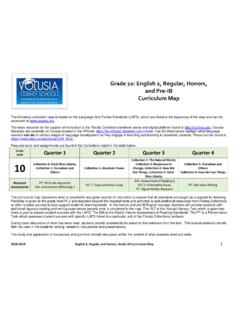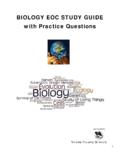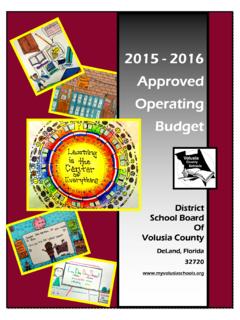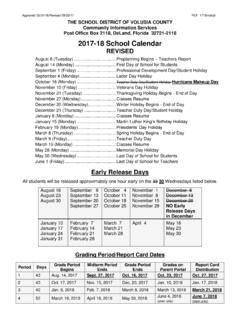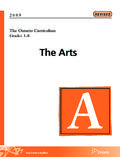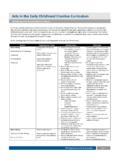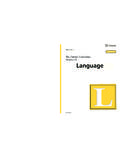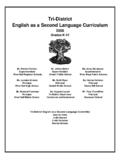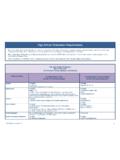Transcription of 2D Studio Art 1 - Volusia County Schools
1 Page 1 visual Art curriculum Map 912 2d studio art 1 0101300 Volusia County Schools ART curriculum Map 2d studio art 1 (0101300) Page 2 visual Art curriculum Map 912 2d studio art 1 0101300 The school Board of Volusia County Mrs. Melody Johnson, Chairman Mrs. Linda Cuthbert, Vice-Chairman Mrs. Ida D. Wright Dr. John Hill Mr. Carl Persis Superintendent of Schools Mr. James T. Russell Chief Academic Officer Ms. Teresa Marcks Director K-12 curriculum Ms. Rachel Hazel K-12 visual Art curriculum Specialist Ms. Beth Dobberstein July 2015 Vision Statement Through the individual commitment of all, our students will graduate with the knowledge, skills, and values necessary to be successful contributors to our democratic society.
2 Page 3 visual Art curriculum Map 912 2d studio art 1 0101300 2d studio art 1 (0 101300) Version Description: Students experiment with the media and techniques used to create a variety of two-dimensional (2-D) artworks through the development of skills in drawing, painting, printmaking, collage, and/or design. Students practice, sketch, and manipulate the structural elements of art to improve mark making and/or the organizational principles of design in a composition from observation, research, and/or imagination. Through the critique process, students evaluate and respond to their own work and that of their peers. This course incorporates hands-on activities and consumption of art materials.
3 - Respect is shown for the artwork of peers and copyrighted works of others. - Students have opportunities to build 21st century skills to aid them in high school and well beyond. - All instruction related to visual Art benchmarks should be framed by the Big Ideas and Enduring Understandings. Big Ideas are the major organizing points for arts education in Florida and provide a broad overview of what students should know and be able to do. They include descriptive material to help focus sequential instruction throughout K-12. Big Ideas are not designed for measurement purposes The Enduring Understandings (EUs) are subsets of the Big Ideas, providing a more focused view of arts education and targeted understandings for Florida s students to begin building during the primary grades, where foundations are laid, through to students arts experiences in high school and beyond.
4 Like the Big Ideas, they are not designed for assessment purposes; rather they re expressed in general terms that will allow arts teachers at the classroom level to identify or design Essential Questions for planning purposes. Benchmarks/standards drive instruction in Florida s classrooms and, therefore, have been made specific and measurable. Organized under each Big Idea and Enduring Understanding, the benchmarks/standards explicitly describe what students should know and be able to do in visual Art. These standards/benchmarks address other topics of learning such as literacy, math, civic engagement, problem-solving, creativity, innovation, cross-cultural understandings, - 21st-century skills and the importance of concepts involving learning and the brain such as cognition, sequencing, filtering, and delaying gratification.
5 - The Florida Core Standards are incorporated into every Volusia County Art course. Page 4 visual Art curriculum Map 912 2d studio art 1 0101300 HOW TO INTERPRET THE curriculum MAP visual Art curriculum Map Top of Map: course, grade level, and quarter in large font visual ART 0101300 2d studio art 1 912 1st Quarter, Recommended Topic, Art Standard (learning target/skills) and Standard # are all in white font on dark background for easier finding as noted by: Recommended Topics: Topics of art content are repeated among the 4 quarters with recommended lessons/activities and artists per topic. Integrated connections are listed per quarter for language arts, math, science, and social studies.
6 Florida Standards Required by Florida DOE for this Course Course Number: 0101300 2d studio art 1 Determine the meaning of symbols, key terms, and other domain-specific words and phrases as they are used in a specific scientific or technical context relevant to grades 910 texts and topics. Initiate and participate effectively in a range of collaborative discussions (one-on-one, in groups, and teacher-led) with diverse partners on grades 910 topics, texts, and issues, building on others ideas and expressing their own clearly and persuasively. Come to discussions prepared, having read and researched material under study; explicitly draw on that preparation by referring to evidence from texts and other research on the topic or issue to stimulate a thoughtful, well-reasoned exchange of ideas.
7 Work with peers to set rules for collegial discussions and decision-making ( , informal consensus, taking votes on key issues, presentation of alternate views), clear goals and deadlines, and individual roles as needed. Propel conversations by posing and responding to questions that relate the current discussion to broader themes or larger ideas; actively incorporate others into the discussion; and clarify, verify, or challenge ideas and conclusions. Respond thoughtfully to diverse perspectives, summarize points of agreement and disagreement, and, when warranted, qualify or justify their own views and understanding and make new connections in light of the evidence and reasoning presented.
8 Integrate multiple sources of information presented in diverse media or formats ( , visually, quantitatively, orally) evaluating the credibility and accuracy of each source. Evaluate a speakers point of view, reasoning, and use of evidence and rhetoric, identifying any fallacious reasoning or exaggerated or distorted evidence. Present information, findings, and supporting evidence clearly, concisely, and logically such that listeners can follow the line of reasoning and the organization, development, substance, and style are appropriate to purpose, audience, and task. Produce clear and coherent writing in which the development, organization, and style are appropriate to task, purpose, and audience.
9 Draw evidence from informational texts to support analysis, reflection, and research. Mathematical Practices : Use appropriate tools strategically. : Attend to precision. : Look for and make use of structure. Rubrics FAEA Rubric for completed 2D art work General visual Art Rubric located in Preface Rubric for Language Arts/Conventions Resources in Preface: Discovering Drawing Drawing Assessment 2D Careers Artists;; 21st Century Skills Q1 Page 5 visual Art curriculum Map 912 2d studio art 1 0101300 Florida Art Education Association -Annual Student Adjudicated Exhibit Research Based HOLISTIC RUBRIC Grades 9-12 ASSESSMENT IN 2D Art Aligned with Volusia County Report Card Grading General visual Arts Rubric LEVEL 4 RANGE 90 -100% (A = - )
10 Shows obvious evidence of thinking and decision making Addresses complex visual or conceptual ideas Shows inventiveness and imagination Shows experimentation and/or risk-taking Reflects sensitivity and/or subtlety Shows excellent compositional skills Shows evidence of style and format 4 Points A score of four is a response in which the student demonstrates a thorough understanding of visual art concepts and/or procedures embodied in the task. The student has responded correctly to the task, used artistically sound procedures, and provided clear and complete explanations and interpretations. 3 Points A score of three is a response in which the student demonstrates an understanding of visual art concepts and/or procedures embodied in the task.



